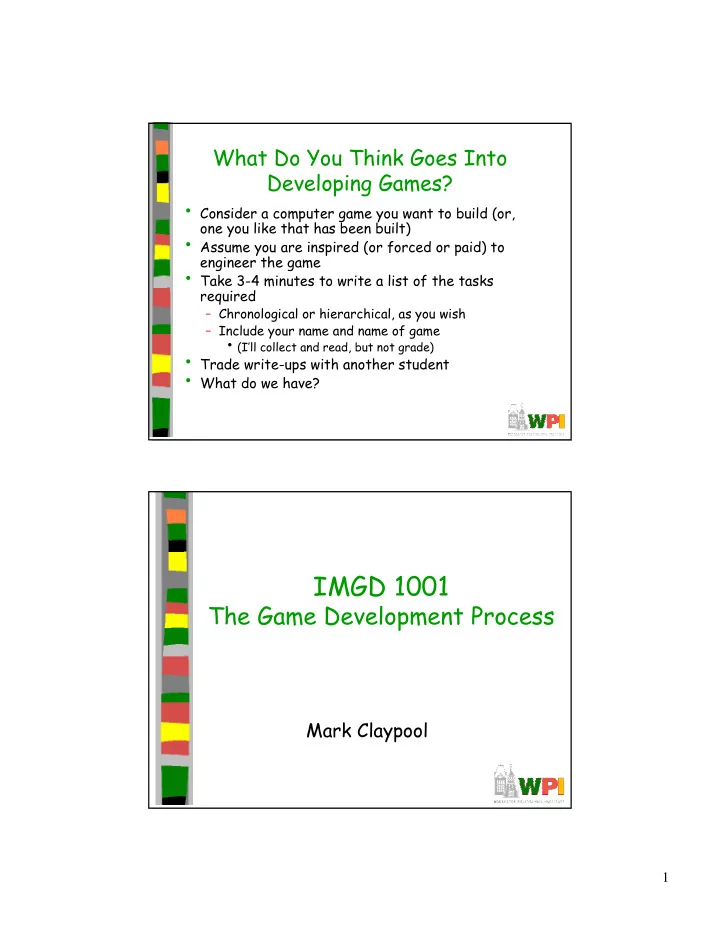

What Do You Think Goes Into Developing Games? • Consider a computer game you want to build (or, one you like that has been built) • Assume you are inspired (or forced or paid) to engineer the game • Take 3-4 minutes to write a list of the tasks required – Chronological or hierarchical, as you wish – Include your name and name of game • (I’ll collect and read, but not grade) • Trade write-ups with another student • What do we have? IMGD 1001 The Game Development Process Mark Claypool 1
Topics • Background • Topics • Course Materials • Motivation Professor Background (Who am I?) • Dr. Mark Claypool (professor, “Mark”) – Computer Science • Operating Systems, Distributed Computer Systems, Multimedia, Networks – Director of the IMGD program • The Game Development Process • Research interests – Networks, Multimedia, Network games, Performance 2
Student Background (Who Are You?) • Year (freshman, sophomore, …) • Major (IMGD (Art or Tech), CS, HUA, …) • Programming Classes • Gamer: (casual) 1 to 5 (hard-core) • Number of Games Built (zero is ok) • Other … Syllabus Stuff http://www.cs.wpi.edu/~claypool/courses/1001-C06/ • Office hours: – TBA (about 3 per week each) – See Web page • Email: – {claypool, chocobo7, pbd} at cs.wpi.edu – id111x-ta at cs.wpi.edu – id111x-all at cs.wpi.edu 3
Course Materials • Slides – On the Web – PPT and PDF – Caution! Don’t rely upon the slides alone! Use them as supplementary material • (come to class) • Timeline – Tentative planning • Resources – Game creation toolkits, documentation, etc. Text Books • Course packet from several text books • The Game Development Process – By lots of people, edited by Steve Rabin – Close to course material, required for this class – 1000 pages! But good reference • Game Architecture and Design - A New Edition – by Andrew Rollings and Dave Morris – Heavily used for design • On Game Design – by Andrew Rollings and Ernest Adams – Some solid game design material • Designing Arcade Computer Game Graphics – by Ari Feldman – Creating 2D art for games • Creating the Art of the Game – by Matthew Omernick – Creating 3D art for games 4
Course Structure • Prerequisites • Out-of-Class – None! – Reading – Neither Programming – Projects • Grading nor Art • In-Class – Exams (45%) – Lecture – Projects (50%) – Discussion – Other (5%) – Exams (More on Exams and Projects, next) Exams • 2 exams • 45% of grade • Non-cumulative • Closed-note • Closed-paper • Closed-friend • One-page “crib-sheet” (handwritten) 5
Projects (1 of 2) • About 7 projects – 3 are tutorials with some “add ons” – 4 are original, made from “scratch” • 45% of your grade • Groups (3 is good, 2 or 4 are possible) • Apply concepts taught in class • Related to Game Development • Build upon each other – Should have working game at end! Projects (2 of 2) • Project 4: Game Inception and Design – Inspiration of a game, design and documentation • Project 5: Content Creation – Create 2-d animated sprites (or other art) and select supporting content • Project 6: Game Logic – Implement game objects and game rules • Project 7: Level Design – Put above components together in compelling game • Project pitch – To panel of experts 6
Topics • Game Design • Introduction – The Creative Process – Team – Design Documentation – Timeline • Artistic Content – Size and Shape • Engineering Creation – Color and Displays – Game Architectures – 2D and 3D – Programming • Graphics • Misc • Animation – Release – Audio • Music – Postmortem • Sound Effects Why This Class? • IMGD requirements (Core Course, see www.wpi.edu/+IMGD) IMGD Core Technical Artistic H&A Area Area Technical Sufficiency Sufficiency IMGD IMGD Advanced Advanced Social IQP Science Electives MQP MQP • Introduction to steps of Game Development – In depth in Area • Fun! (“ passion for games” ) 7
Recommend
More recommend